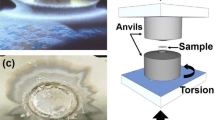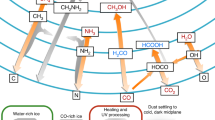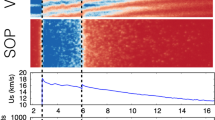Abstract
Delivery of prebiotic compounds to early Earth from an impacting comet is thought to be an unlikely mechanism for the origins of life because of unfavourable chemical conditions on the planet and the high heat from impact. In contrast, we find that impact-induced shock compression of cometary ices followed by expansion to ambient conditions can produce complexes that resemble the amino acid glycine. Our ab initio molecular dynamics simulations show that shock waves drive the synthesis of transient C–N bonded oligomers at extreme pressures and temperatures. On post impact quenching to lower pressures, the oligomers break apart to form a metastable glycine-containing complex. We show that impact from cometary ice could possibly yield amino acids by a synthetic route independent of the pre-existing atmospheric conditions and materials on the planet.
This is a preview of subscription content, access via your institution
Access options
Subscribe to this journal
Receive 12 print issues and online access
$259.00 per year
only $21.58 per issue
Buy this article
- Purchase on Springer Link
- Instant access to full article PDF
Prices may be subject to local taxes which are calculated during checkout




Similar content being viewed by others
References
Brack, A. From interstellar amino acids to prebiotic catalytic peptides: a review. Chem. Biodiv. 4, 665–679 (2007).
Nelson, K. E., Levy, M. & Miller, S. L. Peptide nucleic acids rather than RNA may have been the first genetic molecule. Proc. Natl Acad. Sci. USA 97, 3868–3871 (2000).
Barbier, B., Visscher, J. & Schwartz, A. W. Polypeptide-assisted oligomerization of analogs in dilute aqueous solution. J. Mol. Evol. 37, 554–558 (1993).
Miller, S. L. A production of amino acids under possible primitive earth conditions. Science 117, 528–529 (1953).
Miller, S. L. & Urey, H. C. Organic compound synthesis on the primitive earth. Science 130, 245–251 (1959).
Bar-Nun, A., Bar-Nun, N., Bauer, S. H. & Sagan, C. Shock synthesis of amino acids in simulated primitive environments. Science 168, 470–473 (1970).
McKay, C. P. & Borucki, W. J. Organic synthesis in experimental impact shocks. Science 276, 390–392 (1997).
Fegley, B. Jr, Prinn, R. G., Hartman, H. & Watkins, G. H. Chemical effects of large impacts on the Earth's primitive atmosphere. Nature 319, 305–308 (1986).
Ehrenfreund, P. & Charnley, S. B. Organic molecules in the interstellar medium, comets, and meteorites: a voyage from dark clouds to the early earth. Annu. Rev. Astron. Astrophys. 38, 427–483 (2000).
Ehrenfreund, P. et al. Astrophysical and astrochemical insights into the origin of life. Rep. Prog. Phys. 65, 1427–1487 (2002).
Elsila, J. E., Glavin, D. P. & Dworkin, J. P. Cometary glycine detected in samples returned by stardust. Meteorit. Planet. Sci. 44, 1323–1330 (2009).
Muñoz Caro, G. M. M. et al. Amino acids from ultraviolet irradiation of interstellar ice analogues. Nature 416, 403–406 (2002).
Blank, J. G., Miller, G. H., Ahrens, M. J. & Winans, R. E. Experimental shock chemistry of aqueous amino acid solutions and the cometary delivery of prebiotic compounds. Origins Life Evol. B 31, 15–51 (2001).
Meech, K. J., Hainaut, O. R. & Marsdenc, B. G. Comet nucleus size distributions from HST and Keck telescopes. Icarus 170, 463–491 (2004).
Robertson, D. H., Brenner, D. W. & White, C. T. Split shock wave from molecular dynamics. Phys. Rev. Lett. 67, 3132–3135 (1991).
Gahagan, K. T., Moore, D. S., Funk, D. J., Rabie, R. L. & Buelow, S. J. Measurement of shock wave rise times in metal thin films. Phys. Rev. Lett. 85, 3205–3208 (2000).
Kadau, K., Germann, T. C., Lomdhal, P. S. & Holian, B. L. Microscopic view of structural phase transitions induced by shock waves. Science 296, 1681–1684 (2002).
Chyba, C. F., Thomas, P. J., Brookshaw, L. & Sagan, C. Cometary delivery of organic molecules to early earth. Science 249, 366–373 (1990).
Pierazzo, E., Kring, D. A. & Melosh, H. J. Hydrocode simulation of the Chicxulub impact event and the production of climatically active gases. J. Geophys. Res. 103, 28607–28625 (1998).
Furukawa, Y., Sekine, T., Oba, M., Kakegawa, T. & Nakazawa, H. Biomolecule formation by oceanic impacts on early Earth. Nature Geosci. 2, 62–66 (2009).
Bernstein, M. P., Dworkin, J. P., Sandford, S. A., Cooper, G. W. & Allamandola, L. J. Racemic amino acids from the ultraviolet photolysis of interstellar ice analogues. Nature 416, 401–403 (2002).
Huber, C. & Wächterhäuser, G. Peptides by activation of amino acids with CO on (Ni,Fe)S surfaces: implications for the origin of life. Science 281, 670–672 (1998).
Gygi, F. & Galli, G. Electronic excitations and the compressibility of deuterium. Phys. Rev. B 65, 220102 (2002).
Kress, J. D., Mazevet, S., Collins, L. A. & Wood, W. W. Density-functional calculation of the Hugoniot of shocked liquid nitrogen. Phys. Rev. B 63, 024203 (2000).
Mundy, C. J. et al. Ultrafast transformation of graphite into diamond: an ab initio study of graphite under shock compression. J. Chem. Phys. 128, 184701 (2008).
Goncharov, A. F. et al. Dynamic ionization of water under extreme conditions. Phys. Rev. Lett. 94, 125508 (2005).
Schwegler, E., Sharma, M., Gygi, F. & Galli, G. Melting of ice under pressure. Proc. Natl Acad. Sci. USA 105, 14779–14783 (2008).
Goldman, N. et al. Ab initio simulation of the equation of state and kinetics of shocked water. J. Chem. Phys. 130, 124517 (2009).
Reed, E. J., Manaa, M. R., Fried, L. E., Glaesemann, K. R. & Joannopoulos, J. D. A transient semimetallic layer in detonating nitromethane. Nature Phys. 4, 72–76 (2008).
Reed, E. J., Fried, L. E. & Joannopoulos, J. D. A method for tractable dynamical studies of single and double shock compression. Phys. Rev. Lett. 90, 235503 (2003).
Reed, E. J., Fried, L. E., Henshaw, W. D. & Tarver, C. M. Simulation technique for steady shock waves in materials with analytical equations of state. Phys. Rev. E 74, 056706 (2006).
Reed, E. J., Maiti, A. & Fried, L. E. Anomalous sound propagation and slow kinetics in dynamically compressed amorphous carbon. Phys. Rev. E 81, 016607 (2009).
Walsh, J. M. & Rice, M. H. Dynamic compression of liquids from measurements on strong shock waves. J. Chem. Phys. 26, 815–823 (1957).
Mitchell, A. C. & Nellis, W. J. Equation of state and electrical conductivity of water and ammonia shocked to the 100 GPa (1 Mbar) pressure range. J. Chem. Phys. 76, 6273–6281 (1982).
Shoemaker, E. M. in The Physics and Astronomy of the Moon (ed. Kopal, Z.) 283–359 (Academic Press, 1962).
Beer, E., Podolak, M. & Prialnik, D. The contribution of icy grains to the activity of comets I. Grain lifetime and distribution. Icarus 180, 473–486 (2006).
Yano, K. & Horie, Y. Discrete-element modeling of shock compression of polycrystalline copper. Phys. Rev. B 59, 13672–13680 (1999).
Goldman, N., Fried, L. E., Kuo, I.-F. W. & Mundy, C. J. Bonding in the superionic phase of water. Phys. Rev. Lett. 94, 217801 (2005).
Goldman, N. & Fried, L. E. First principles simulation of a superionic phase of hydrogen fluoride (HF) at high pressures and temperatures. J. Chem. Phys. 125, 044501 (2006).
Goldman, N. & Fried, L. E. X-ray scattering intensities of water at extreme conditions. J. Chem. Phys. 126, 134505 (2007).
Geissler, P. L., Dellago, C. D., Chandler, D., Hutter, J. & Parrinello, M. Autoionization in liquid water. Science 291, 2121–2124 (2001).
Wu, C., Fried, L. E., Yang, L. H., Goldman, N. & Bastea, S. Catalytic behaviour of dense hot water. Nature Chem. 1, 57–62 (2009).
Bastea, S. & Fried, L. E. Exp6-polar thermodynamics of dense supercritical water. J. Chem. Phys. 128, 174502 (2008).
Klamt, A. COSMO-RS: From Quantum Chemistry to Fluid Phase Dynamics and Drug Design (Elsevier, 2005).
Patterson, J. E., Dreger, Z. A., Miao, M. & Gupta, Y. M. Shock wave induced decomposition of RDX: time-resolved spectroscopy. J. Phys. Chem. A 112, 7374–7382 (2008).
VandeVondele, J. et al. Quickstep: fast and accurate density functional calculations using a mixed Gaussian and plane waves approach. Comp. Phys. Comm. 167, 103–128 (2005).
Goedecker, S., Teter, M. & Hutter, J. Separable dual-space gaussian pseudopotentials. Phys. Rev. B 54, 1703–1710 (1996).
Becke, A. D. Density-functional exchange-energy approximation with correct asymptotic behavior. Phys. Rev. A 38, 3098–3100 (1988).
Lee, C., Yang, W. & Parr, R. G. Development of the Colle–Salvetti correlation-energy formula into a functional of the density. Phys. Rev. B 37, 785–789 (1988).
Zel'dovitch, Y. B. & Raizer, Y. P. Physics of Shock Waves and High-Temperature Hydrodynamic Phenomena (Dover Publications, 2002).
Acknowledgements
This work was performed under the auspices of the US Department of Energy by Lawrence Livermore National Laboratory (LLNL) under Contract DE-AC52-07NA27344. The project 06-ERD-037 was funded by the Laboratory Directed Research and Development Program at LLNL. Computations were performed at LLNL using the massively parallel computers Thunder, ATLAS, uP, UM, UV, Gauss and Prism. We acknowledge L. Krauss for help with constructing the graphics in Figs 2 and 4.
Author information
Authors and Affiliations
Contributions
N.G. originated the central idea for this work and performed and analysed the simulations. E.J.R. is lead author for the MSST algorithm and helped write the paper. L.E.F. co-created the MSST algorithm, wrote the molecular analyser code and helped write this paper. I.W.K. helped with the initial equilibration simulations. A.M. performed the Gibbs free energy of reaction calculations.
Corresponding author
Ethics declarations
Competing interests
The authors declare no competing financial interests.
Supplementary information
Supplementary information
Supplementary information (PDF 483 kb)
Rights and permissions
About this article
Cite this article
Goldman, N., Reed, E., Fried, L. et al. Synthesis of glycine-containing complexes in impacts of comets on early Earth. Nature Chem 2, 949–954 (2010). https://doi.org/10.1038/nchem.827
Received:
Accepted:
Published:
Issue Date:
DOI: https://doi.org/10.1038/nchem.827



